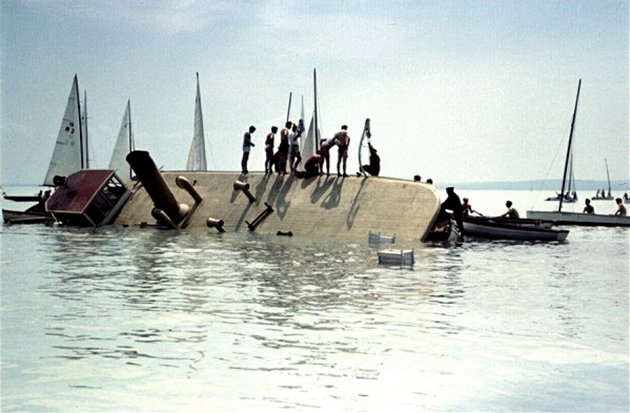Concealed the Hungarian AVH is the largest ship disaster
65 years ago, on 30 May 1954, water, mass Hungary worst: the child day capsized on Lake Balaton the Sidekick steamer, 23 people were killed. The accident értesülhetett the public only a few decades later. The victims memorial now stands in Balatonfüred Tagore promenade.
The screw steamer was built in 1918 at the Schlick-Nicholson Machine, Waggon and Shipyard. For a long time it carried passengers between the two banks of the Danube, it sank in the height of Markó Street in the Second World War. A year later, it was highlighted and put back on the market, and in 1950 it was transferred to the ownership of the Balaton Shipping Company.
This was necessary because at the end of the Second World War the retreating Germans blew up the boats on Lake Balaton, and in the early fifties there was nothing for the masses who came to the lake to holiday.
The steamer, which was floated up the Sió Canal, was converted together with its two companions in the workshop of the BHV in Siófok, and was then named Pajtás. The roof was extended by six meters, the lifeboats were placed above the deck, and its capacity was increased from 150 to 200 people.
During the conversion, even the most basic technical requirements were not taken into account: a larger bolt of the Jókai screw steamer was installed on the Pajtás, so after the start, the stern of the ship rose, its bow sank, and its stability decreased. Due to the wave resistance, the side height was increased, but this also increased the height of the center of gravity, and no technical and stability tests were performed.
The captain of the spectacularly swaying and roaring ship was the problem, but this was not addressed by the authorities during the period of sabotage charges.
The tragedy occurred on May 30, 1954. Early in the morning, the Buddy ran out of the Balatonfüred boat station in bright weather, with six crew and about 180 passengers on board, many of whom celebrated Children's Day with the cruise.
When the Buddy turned sharply to Tihany with a sharp right turn, the season-opening sailing competition was just starting on the other side of the pier. Most of the passengers crashed to the left side of the ship by the time the vehicle tilted sharply. The frightened people were now rushing to the other side, causing the already shaky ship to tip to the right.
The captain tried to balance the tilt by turning the rudder, but he was unsuccessful, the Pajtás tilted to the left again and began to sink. 22 passengers and the heater died in the wave grave (the youngest victim was seven years old, the oldest was 68), the heater prevented an even bigger disaster because it was still able to release the steam from the boiler, so the ship did not explode.
 The Pajtás, sitting on the bottom, was half out of the water, so most of the passengers could climb onto its sides and top. The participants of the sailing race quickly started the rescue, and many of those standing on the shore also helped.
The Pajtás, sitting on the bottom, was half out of the water, so most of the passengers could climb onto its sides and top. The participants of the sailing race quickly started the rescue, and many of those standing on the shore also helped.
State security officers arrived on the scene within minutes, but did not deal with the rescue. The pier was closed, even the police were not allowed there, and even the Minister of Transport had difficulty getting in. They pulled the film out of the tourists' cameras, the witnesses were threatened not to tell anyone about what they saw, and even the local telephone exchange was taken under their control.
The political leadership only made sure that the world did not learn about the misfortune. There was only one terse announcement about the accident in the party newspaper Szabad Nép, which reported 12 deaths. After that, Mátyás Rákosi ordered a complete news blackout.
Pál Heisz, the captain of the Pajtás, was immediately arrested after the fatal accident, and was in pre-trial detention for eight months. The logbook fished out of the water certified that the vehicle was not overloaded, thus avoiding the death penalty. He did not get a job for a long time, and eventually became a supervisor at the port in Siófok, he never told anyone about the accident.
After the tragedy, the Buddy was lifted out of the water, rebuilt into a twin-screw motorboat in 1957, and its name was changed to Siófok. It was sailed to the Danube in 1959, where it continued to serve as Dömsöd, and was withdrawn from circulation in 1987. The monument to the victims of the Pajtás ship, the work of Béla Raffay, was unveiled in 1999 on the Tagore promenade in Balatonfüred.
Source: long-kor store
890 total views, 1 today
890 total views, 1 today










